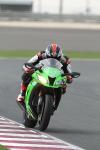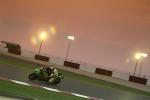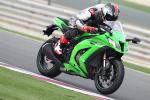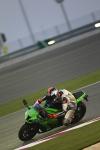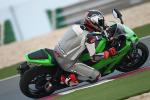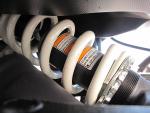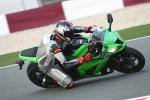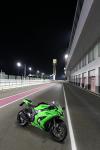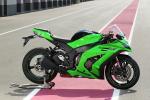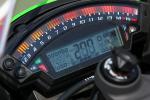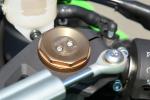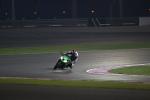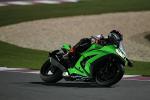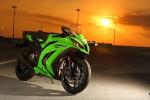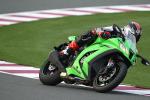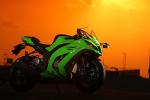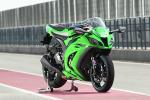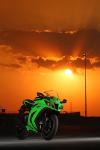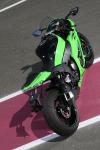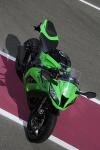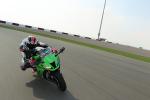Kawasaki ZX-10R Ninja 2011 review
By Kevin Ash - 27/08/2011
How times have changed: this is the first presentation of a Japanese superbike where the benchmark, the bike to beat, is not another Japanese superbike!
Indeed there are two European machines setting standards which Kawasaki‘s all new Ninja ZX-10R must measure itself against: BMW‘s epochal S1000RR, and Aprilia‘s RSV4 Factory APRC SE.
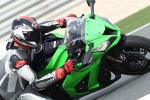
In terms of sheer top end horsepower, the BMW has blown the opposition into the weeds, its claimed 190bhp (193PS, 142kW) unprecedentedly translating into almost as much at the back wheel. Japanese power claims are made much further up the driveline, and some 25bhp seems to be lost along the way, but now Kawasaki is saying it latest, fastest, highest tech and lightest litre Ninja makes a monster 197bhp (200.1PS, 147.1kW), which should put it in with a fighting chance against the Bavarian blaster.
As always in modern bike design, the ZX-10R engine has been built to work with the chassis as well as making plenty of useable power, which is why the crankshaft has been raised compared with the previous version, to help bring the major masses closer to the centre of gravity and the roll axis. This has meant flipping the gearbox layout upside down so the input shaft now sits above the output shaft. To compensate for raising the mass the fuel tank sits further back and down, lowering the fuel‘s mass and bring that closer to the bike‘s centre too. Overall the centre of gravity is a little lower (by 4mm, though this will depend on fuel load), while centralising the masses this way is designed to improve agility by reducing the inertial moment.

The cylinder layout is désaxé (technical feature here), meaning the bores are offset in relation to the crankshaft, in the Ninja‘s case by 2mm, towards the intake side of the engine. This means the Ninja's conrods on the power stroke are at less of an angle to the pistons, which in turn experience a lower sidethrust against the cylinder walls, and friction is reduced. It also means lighter pistons can be used as they don‘t need to be so strong.
Other changes are what you‘d expect in the pursuit of more power: larger intake valves with wider intake ports, completely revised exhaust port shapes, while valve lift has been increased by 0.6mm. Valve timing and overlap are changed too. Weight is saved throughout the engine, to the point where the only components that are heavier than before are the conrods.
Breathing is further helped by a larger airbox with a less restrictive shape (mostly due to its higher, arched ceiling) while the ram air effect is made stronger than the 2010 ZX-10R's by positioning the intake further forward where the air pressure is higher. The 197bhp output is claimed to be boosted to 207bhp (209.9PS, 154.4kW) by the pressurising effect of the Ram Air system. There are two fuel injectors per cylinder, the secondary one positioned high into the airbox and operating only on large throttle openings at high revs. This allows the main one to be more finely calibrated for finer fuel metering.

The exhaust header pipes are titanium and almost the same length and bore as the race system‘s, meaning there will be little value in fitting a full aftermarket exhaust, simply removing the catalyst pre-chamber and fitting an end can will have the same effect.
The gearbox is a cassette type, and not just to make production easier (which is the real purpose of most of them) but for genuine race track ratio changes. Kawasaki supplies alternative ratios and they can be changed without having to drain the engine oil.
The ZX-10R's chassis is entirely new too, including the twin spar frame, an all-cast aluminium design which joins headstock to swingarm pivot more directly than before, and which is responsible for the biggest weight saving over the previous model: the 2011 Ninja is claimed to be 22lb (10kg) lighter overall than the 2010 bike.
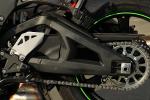
The beautifully constructed and complex swingarm is not as long as some rivals‘ as Kawasaki says a compromise has to be struck between rider feedback and grip, and a shorter one is better for feedback. But it‘s still longer than the old bike‘s, and the chain adjustment allows for two links to be taken out of the chain to shorten the wheelbase by 16mm, recommended for track use only.
The front end geometry is more radical than before, the rake being half a degree steeper at 25 degrees and the trail reduced by 3mm to 107mm (4.21in), but more weight is carried over the front to reduce the tendency to wheelie and improve stability and feel. These are helped too by the use of Big Piston Forks (click for technical feature).
Kawasaki calls the rear suspension ‘horizontal back link‘, which means the shock is laid almost horizontal above the swingarm, freeing up space lower down for the larger exhaust pre-chamber and keeping the shock further from the heat this generates. It also helps mass centralisation.
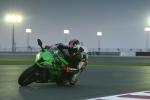
The 2011 ZX-10R Ninja feels light, taut and compact when you swing a leg over the seat, which is 0.67in (17mm) lower than before. The footrests are 5mm lower and can be adjusted 15mm down from that for road riding to improve comfort. The handlebars are angled less than previously too. The motor fires up with a typically aggressive Kawasaki snarl, the coloured LED rev counter lighting up rapidly from left to right as you blip the throttle. Now‘s the time to select the engine and traction control modes, but we‘ll come back to those as you‘re itching to know what the bike‘s like to ride...
It‘s no huge surprise that this latest Kawasaki ZX-10R is searingly quick. Even at the power-disguising Losail circuit test location the bike fires out of turns and sucks up the straights in between like a Dyson gobbling a length of wool. It is phenomenally fast, although you soon discover it really does want to be revved, with the meat of the power only coming on song at 8,000rpm and the serious stuff chiming in another 2,000rpm later. Maximum torque‘s at 11,500rpm and maximum power at 13,000rpm, and if you let the revs drop too far there‘s not a huge amount of muscle to help you out.

This is all relative of course, on the roads the bike will likely feel very rapid much further down the rev range, but riders will be buying this bike for the big slug of thrust it can deliver, and to experience that you need to spin the motor hard. The figures do underline this: the S1000RR has an identical peak torque figure of 83lb.ft (112Nm) as the Ninja ZX-10R, but this occurs at 9,750rpm on the BMW as against the Kawasaki‘s much revvier 11,500rpm. Looked at another way, it means the ZX-10R is weaker than the BMW at 9,750rpm, although it‘s a little stronger than the RR‘s 80lb.ft (109Nm) at 11,500rpm - in other words, it‘s a peakier engine.
It‘s quite tall geared too, with first and second enough for most of the Losail track and probably most UK circuits too, with the occasional dabble into third, and the higher ratios only for longer straights. At the end of Losail‘s the bike was hitting an indicated 174mph (280kph) in fifth, and there aren‘t many tracks where you‘d get much more than that. It could be this which dilutes the feeling of thrust a little, or simply the circuit itself, but despite the peak power claim appearing to be a match for the BMW‘s, the 2011 Ninja doesn‘t feel as if it has the German bike‘s final insane hit of missile rocket thrust.
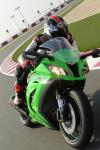
It‘s weaker in the 8,000-10,500rpm region in particular, which you do use because the tall gearing spaces out the ratios. It could be the delivery is more linear too, but the seat of my Alpinestars told me it‘s not quite as mentally fast as the S1000RR. It‘s closer to the Aprilia RSV4 Factory in this respect, which is hardly a disgrace, but the engine hasn‘t moved the game forward in performance terms. The gearchanging itself is reliable and positive although the box can baulk at upchanging during full bore acceleration without a quick dip of the clutch.
There‘s one blemish in the power delivery too. Mostly the fuelling is perfect, and the motor is beautifully smooth too in terms of vibration, but there‘s a glitch on the throttle off to on, mid-corner situation. Peel down to the apex with the twistgrip closed, then turn it lightly to feather in some power and a small amount of turn gives you nothing. Turn it slightly more and you get a little too much power, enough to accelerate rather than maintain a steady speed, and consequently the bike can lurch. You learn to get around this on the track, even if it‘s just by banging open the throttle and letting the traction control sort things out, but at lower road speeds this will lead to some jerkiness in traffic and while bimbling along.

This didn‘t feel noticeably different in the low power engine map mode, designed for rain and slippery road conditions. The ZX-10R's ‘Middle‘ engine map is interesting though, as the mapping changes according to how aggressive you are with the throttle. Use it gently and you get a gentler response and less power available, but twist it open hard and effectively it‘s like using the full power engine map. Throttle use between the two in terms of aggression give you proportionate power and response. It‘s very clever, but in the end it means you get more power the more you open the throttle... isn't that what it‘s there for anyway?
The handling though is sublime, and it was telling that very few riders were even bothering to alter the suspension settings. The 2011 Ninja was set up only slightly more firmly than the recommended road settings, which means it will probably feel pretty firm in every day riding, but on the track at least the wheel control is outstanding. Under braking the front end stays remarkably unflustered and keeps responding to rider input accurately and with plenty of feel, turning in sharply even with the back end swaying.

In corners the bike holds its line tightly and keeps doing so even when driving hard from the apex - which you can in genuine safety thanks to the traction control - although the footrests do scrape relatively early even in their higher setting. And that traction control is outstanding, letting the wheel spin up then holding a level of slip rather than cutting it off again. It‘s most like the RSV4 APRC‘s in the amount of feel and control it lends you, which makes it the joint best system available, and while even the best racers can be faster with traction control, it will transform what the average rider can do on a track day. There‘s a certain amount of wheelie control too, although this isn‘t entirely consistent, sometimes allowing high wheelies and other times cutting them off almost as soon as they‘ve started.
Even so, there are many riders who with the 2011 Ninja will be exploring rear wheel drift and even steering for the first time in their lives, as you can do this without any fear of the rear suddenly sliding away or worse, the bike highsiding and flipping you into orbit. Instead you can be leaving thick black lines out of corners like a grand prix god, and even tightening your line by opening the throttle and swinging the back end out.
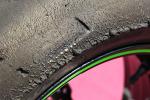
It‘ll cost you in tyres though, they don‘t stand this kind of treatment for very long, and that‘s no slight on the Bridgestone BT-016s fitted to the Ninja. In fact they perform very well, offering massive grip at the rear with accurate tracking from the front - they should do, these particular ones are designed specifically for the 2011 ZX-10R, and even have a slightly different carcass construction to suit the bike better.
There are three levels of traction controlled slippage to choose from, and although this doesn‘t sound much compared with Ducati‘s eight, the range of tyre slip allowed is the same, and the system‘s extra controllability means you‘re better rather than worse off. You can switch between the levels on the move very easily, using a rocker switch on the left handlebar (with the throttle closed).
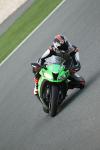
The chassis anyway has that natural, almost telepathic feel you get from the BMW and Honda Fireblade, making it even easier to experiment with the traction control. The bike flicks side to side with an easy agility, although on the few places at Losail where camber changes lighten the front, the bike is eager to flap its bars and shimmy as it‘s accelerating. I suspect this will translate into a pretty lively experience on real world bumpy roads, although the fabulous suspension will help keep things under control, as will the purpose-built, adjustable Öhlins steering damper.
The brakes are notable for their consistency as much as the power. They‘re easy to modulate accurately and thanks to the big piston forks the dive is well controlled and minimal, but they show no signs of fade or changing their character even with repeated hard use. The bike comes with a £1000 race-type ABS option, and as with the traction control, this is highly sophisticated, smooth and dependable. Ultimately a racer will be faster without it, but for occasional track day riders it will allow them to explore the limits of braking in safety and enhance rather than hinder their riding. It‘s very smooth with minimal pulsing at the lever, allowing you to maintain feel and a sense of what the brakes are up to while still knowing that the limit has been reached. Very impressive.
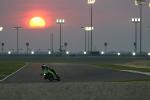
The 2011 Kawasaki ZX-10R Ninja then is right up there with the benchmark bikes, with outstanding handling and a top level traction control system. Overall though, it‘s not quite a match for the BMW in terms of outright performance, seemingly for lacking some power at slightly lower revs than the 13,000rpm peak. It‘s close though, and there are other important factors going for it too. One is Kawasaki‘s outstanding record for reliability and durability, which is significantly better than BMW‘s.
The second is the pricing: at £11,948 (including the 2011 20 per cent VAT rate) the Ninja compares very favourable with the S1000RR‘s £13,270 (with 20 per cent VAT and traction control). Bear in mind the Ninja has traction control as standard. The BMW also has race ABS at that price, but this is not going to be an in-demand option in the UK anyway. The ABS version of the Kawasaki costs £12,969 but that's still below the BMW, and this is all assuming these 2010 BMW prices won't go up for 2011, whereas these are 2011 prices for the Kawasaki.
It‘s not stepped ahead of the Europeans yet, but it‘s the first Japanese superbike in the last two years that looks like it‘s from the same generation. Times have indeed changed.
Kawasaki ZX-10R Ninja 2011 forum thread
Specifications
Model tested: 2011 Kawasaki ZX-10R Ninja
Price: £11,948 (ABS model £12,969)
Available: January 2011
Engine: Inline four cylinder, liquid cooled, dohc 16v, 998cc
Power: 197bhp (200.1PS, 147.1kW) @ 13,000rpm (207bhp (209.9PS, 154.4kW) with Ram Air effect)
Torque: 83lb.ft (112Nm) @ 11,500rpm
Economy: n/a
Tank/Range: 3.75 gallon (17 litre, 4.5 gallons US)/ n/a
Transmission: Six gears, wet slipper clutch, chain final drive
Chassis: Aluminium twin spar
Seat height: 32.0in (813mm)
Wheelbase: 56.1in (1425mm)
Rake/trail: 25 °/ 4.21in (107mm)
Weight: 437lb (198kg) kerb (ABS model: 443lb (201kg))
Donate to the Kevin Ash Fund
Kevin's funeral was held on Thursday 28th February 2013 and was well attended by family, friends and colleagues.
The Telegraph has very kindly established The Telegraph Kevin Ash Fund to assist with the education of Kevin's three daughters.
If you'd like to make a donation then you can use the PayPal 'Donate' button below which will allow you to donate from your PayPal account, or via credit or debit card. A small percentage (about 3.4%) will be retained by PayPal for the service.
Kevin's family have been touched by the generosity and messages of support from people using the website and would like to express their gratitude to those who have contributed in any way.
The donations keep coming in, thank you so much, and the family especially like it when you leave a message.
Home | ![]() facebook.com/KevinAshFund
|
facebook.com/KevinAshFund
| ![]() twitter.com/KevinAshFund | © 2011
twitter.com/KevinAshFund | © 2011
